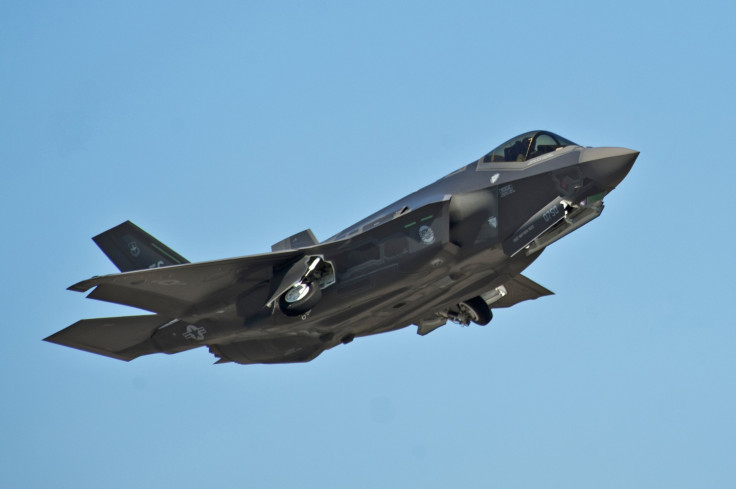Video Shows Pilot Ejecting From Lightning II Fighter Jet Moments Before Runway Crash
KEY POINTS
- F-35B belongs to the F-35 family that includes two other variants — the F-35A and the F-35C
- The F-35B with its capability for short takeoff and vertical landing is a critical part of the Navy's 'lightning carrier' concept
- An F-35B of the US Marine Corps suffered a nose gear collapse recently after an emergency landing in Japan
In yet another bizarre accident caught on camera, an F-35B Lightning II fighter jet crashed with its nose-down at the Naval Air Station Joint Reserve Base in Fort Worth on Thursday. The pilot of the aircraft ejected, and the cause of the crash is under investigation.
This is the second incident involving an F-35B nose-down crash in just two weeks. A video of the incident shared on social media shows an F-35B appearing to conduct a hovering test above the runway as it descends.
The landing gear of the jet could be seen touching the ground. However, the aircraft gently bounces back into the air before crashing nose-first and starting to spin. A few seconds later, the pilot can be seen ejecting from the aircraft.
#Breaking New much clearer video, courtesy Kitt Wilder, of STOL variant F35 B model landing JRB Fort Worth, and pilot ejects. Condition of pilot still unknown. @CBSDFW pic.twitter.com/BeERIeyhtO
— Doug Dunbar (@cbs11doug) December 15, 2022
In an incident reported on Dec. 1, a U.S. Marine Corps F-35B suffered a nose gear collapse after making an emergency landing at Kadena Air Base on the Japanese island of Okinawa. The video of the incident shows the fighter jet bumping up and down while being towed away. The nose gear oleo then breaks, and the aircraft ends up sitting on its nose.
‼️📹🇺🇸✈️🇯🇵Video of today's incident with the Lockheed Martin F-35 fighter of the 121st squadron of the USMC at the Kadena Air Force Base on the Japanese island of Okinawa.
— AZ 🛰🌏🌍🌎 (@AZgeopolitics) December 1, 2022
When towing, the front landing gear dropped pic.twitter.com/0i06pXVPRI
There have also been reports involving another F35 that developed a malfunction, forcing it to make an emergency landing in Norway.
In related news another #F35 had some malfunction and had to make an emergency landing in #Norway this afternoon.
— Varyagi Z ☦ 🇷🇺 (@varyagi) December 1, 2022
Looks a bit steep, but according to local media it was a controlled descent and touched down safely.https://t.co/9LxfxXooEB pic.twitter.com/daQ1KiL9bR
The F-35B belongs to the F-35 family that includes two other variants — the F-35A, which is the conventional takeoff and landing variant — and the F-35C carrier variant. While more than 800 F-35 jets have been delivered so far, its production continues to be marred by delivery delays due to defects and reworks.
The implications of such accidents are far-reaching, as the F-35B is the military's advanced fifth-generation fighter jet designed to replace the Marine Corps fleet of Hornet fighters, which are set to retire in 2030.
With its capability for short takeoff and vertical landing (STOVL), the F-35B is also a critical part of the U.S. Navy's "lightning carrier" concept. The concept seeks to turn amphibious ships into small aircraft carriers. Given the rapid expansion of Chinese naval power, the Navy has been testing the F-35B with the "lightning carrier" concept to expand firepower in the Indo-Pacific region.
The F-35B is considered better when compared to China's J-15 fighters, which is PLA's only carrier-based fighter jet in service.
Commenting about Thursday's incident at Fort Worth, while the Pentagon said that the crashed F-35 hadn't been officially transferred over to government ownership, Lockheed Martin, the company that builds the fighter jet, confirmed the crash and said it occurred on a "shared runway" at the air base.
"We are aware of the F-35B crash on the shared runway at Naval Air Station Joint Reserve Base in Fort Worth and understand that the pilot ejected successfully," Lockheed Martin reportedly said in a statement. "Safety is our priority, and we will follow appropriate investigation protocol."
The facility in Fort Worth is a joint reserve base shared by the Army, Navy, Air Force and Marine reservists. While it is operated by the Navy Reserve, the 10th Air Force is also headquartered there.

© Copyright IBTimes 2024. All rights reserved.






















